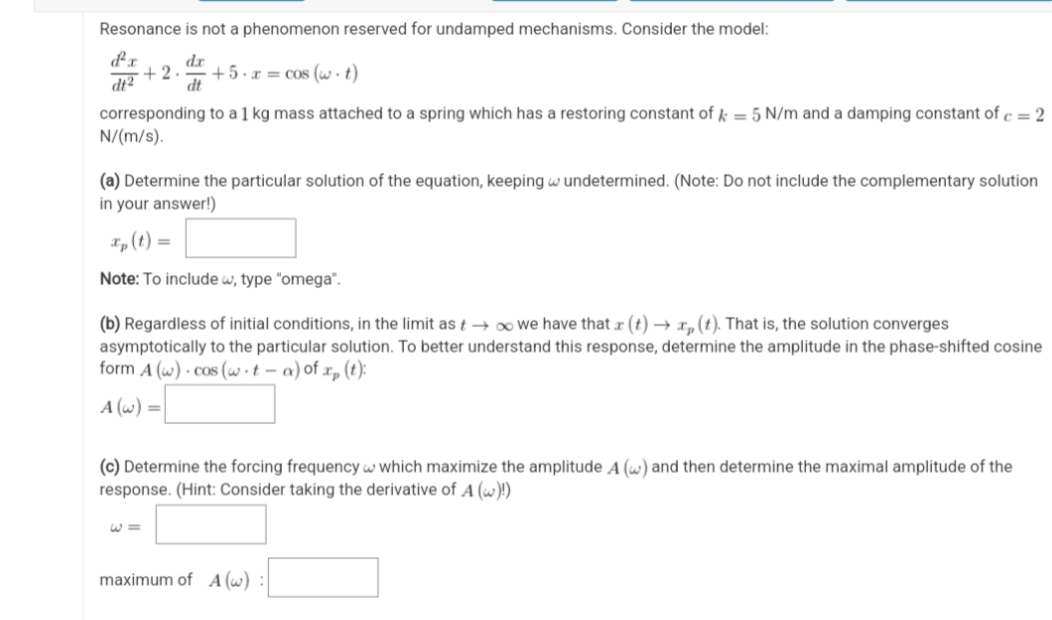Calculus: Early Transcendentals
8th Edition
ISBN:9781285741550
Author:James Stewart
Publisher:James Stewart
Chapter1: Functions And Models
Section: Chapter Questions
Problem 1RCC: (a) What is a function? What are its domain and range? (b) What is the graph of a function? (c) How...
Related questions
Question
Solve all parts in 30 min and get the Thumb up

Transcribed Image Text:Resonance is not a phenomenon reserved for undamped mechanisms. Consider the model:
d'x
dr
+2. +5.x = cos (w t)
dt2
dt
corresponding to a 1 kg mass attached to a spring which has a restoring constant of k = 5 N/m and a damping constant of c = 2
N/(m/s).
(a) Determine the particular solution of the equation, keeping wundetermined. (Note: Do not include the complementary solution
in your answer!)
xp (t) =
Note: To include w, type "omega".
(b) Regardless of initial conditions, in the limit as → ∞ we have that x (t) → x₂ (t). That is, the solution converges
asymptotically to the particular solution. To better understand this response, determine the amplitude in the phase-shifted cosine
form A (w) cos(w t-a) of x₂ (t):
A (w) =
(c) Determine the forcing frequency w which maximize the amplitude A (w) and then determine the maximal amplitude of the
response. (Hint: Consider taking the derivative of A (w)!)
W=
maximum of A (w)
Expert Solution
This question has been solved!
Explore an expertly crafted, step-by-step solution for a thorough understanding of key concepts.
Step by step
Solved in 2 steps with 1 images

Recommended textbooks for you

Calculus: Early Transcendentals
Calculus
ISBN:
9781285741550
Author:
James Stewart
Publisher:
Cengage Learning

Thomas' Calculus (14th Edition)
Calculus
ISBN:
9780134438986
Author:
Joel R. Hass, Christopher E. Heil, Maurice D. Weir
Publisher:
PEARSON

Calculus: Early Transcendentals (3rd Edition)
Calculus
ISBN:
9780134763644
Author:
William L. Briggs, Lyle Cochran, Bernard Gillett, Eric Schulz
Publisher:
PEARSON

Calculus: Early Transcendentals
Calculus
ISBN:
9781285741550
Author:
James Stewart
Publisher:
Cengage Learning

Thomas' Calculus (14th Edition)
Calculus
ISBN:
9780134438986
Author:
Joel R. Hass, Christopher E. Heil, Maurice D. Weir
Publisher:
PEARSON

Calculus: Early Transcendentals (3rd Edition)
Calculus
ISBN:
9780134763644
Author:
William L. Briggs, Lyle Cochran, Bernard Gillett, Eric Schulz
Publisher:
PEARSON

Calculus: Early Transcendentals
Calculus
ISBN:
9781319050740
Author:
Jon Rogawski, Colin Adams, Robert Franzosa
Publisher:
W. H. Freeman


Calculus: Early Transcendental Functions
Calculus
ISBN:
9781337552516
Author:
Ron Larson, Bruce H. Edwards
Publisher:
Cengage Learning